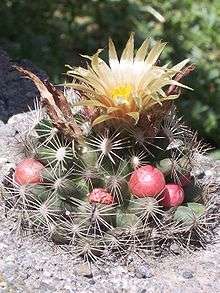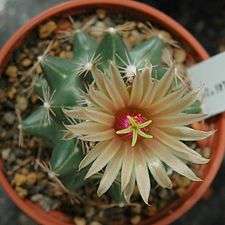Escobaria missouriensis
| Escobaria missouriensis | |
|---|---|
 | |
| Scientific classification | |
| Kingdom: | Plantae |
| (unranked): | Angiosperms |
| (unranked): | Eudicots |
| (unranked): | Core eudicots |
| Order: | Caryophyllales |
| Family: | Cactaceae |
| Subfamily: | Cactoideae |
| Tribe: | Cacteae |
| Genus: | Escobaria |
| Species: | E. missouriensis |
| Binomial name | |
| Escobaria missouriensis | |
| Synonyms[1] | |
|
Synonymy
| |

Escobaria missouriensis, the Missouri foxtail cactus and formerly Coryphantha missouriensis, is a species of low-growing North American cacti. It is found in along the Missouri River in the tallgrass prairie and shortgrass Great Plains, from Texas to Montana and the Dakotas, and in the Rocky Mountains woodlands of Ponderosa pine (Pinus ponderosa), pinyon-juniper, and Gambel oak (Quercus gambelii) west of it. It is also native to the Southwestern United States in Arizona, New Mexico, and Utah.[2][3][4]
Description
Escobaria missouriensis grows up to 30 centimetres (12 in) high and forms clumps to 30 centimetres (12 in) or greater in diameter. They are generally larger in the Southwest. The plants are primarily unbranched, except eastern populations that can be profusely branched. The spines are bright white, pale gray, or pale tan, weathering to gray or yellowish brown.[2] The plant blooms in April to June, with flowers that are pale greenish yellow to yellow-green with midstripes of green or rose-pink to pale brown.[2][5]
Escobaria missouriensis has been extirpated from many of its historically known sites by introduced fire ants, suburban development, brush encroachment following fire suppression, and over-grazing.[2]
- Subspecies[1]
- Escobaria missouriensis subsp. asperispina (Boed.) N.P.Taylor
- Escobaria missouriensis subsp. missouriensis
References
- 1 2 The Plant List, Escobaria missouriensis (Sweet) D.R.Hunt
- 1 2 3 4 Flora of North America, Missouri foxtail cactus Coryphantha missouriensis . accessed 4.4.2011
- ↑ United States Department of Agriculture plants profile, Escobaria missouriensis . accessed 4.4.2011
- ↑ Biota of North America Program, 2014 county distribution map
- ↑ NPIN_Escobaria missouriensis . accessed 4.4.2011
External links
| Wikimedia Commons has media related to Escobaria missouriensis. |
- Flora of North America — Coryphantha missouriensis (Escobaria missouriensis)
- United States Department of Agriculture Plants Profile: Escobaria missouriensis
- Lady Bird Johnson Wildflower Center, University of Texas: Escobaria missouriensis (Missouri foxtail cactus)